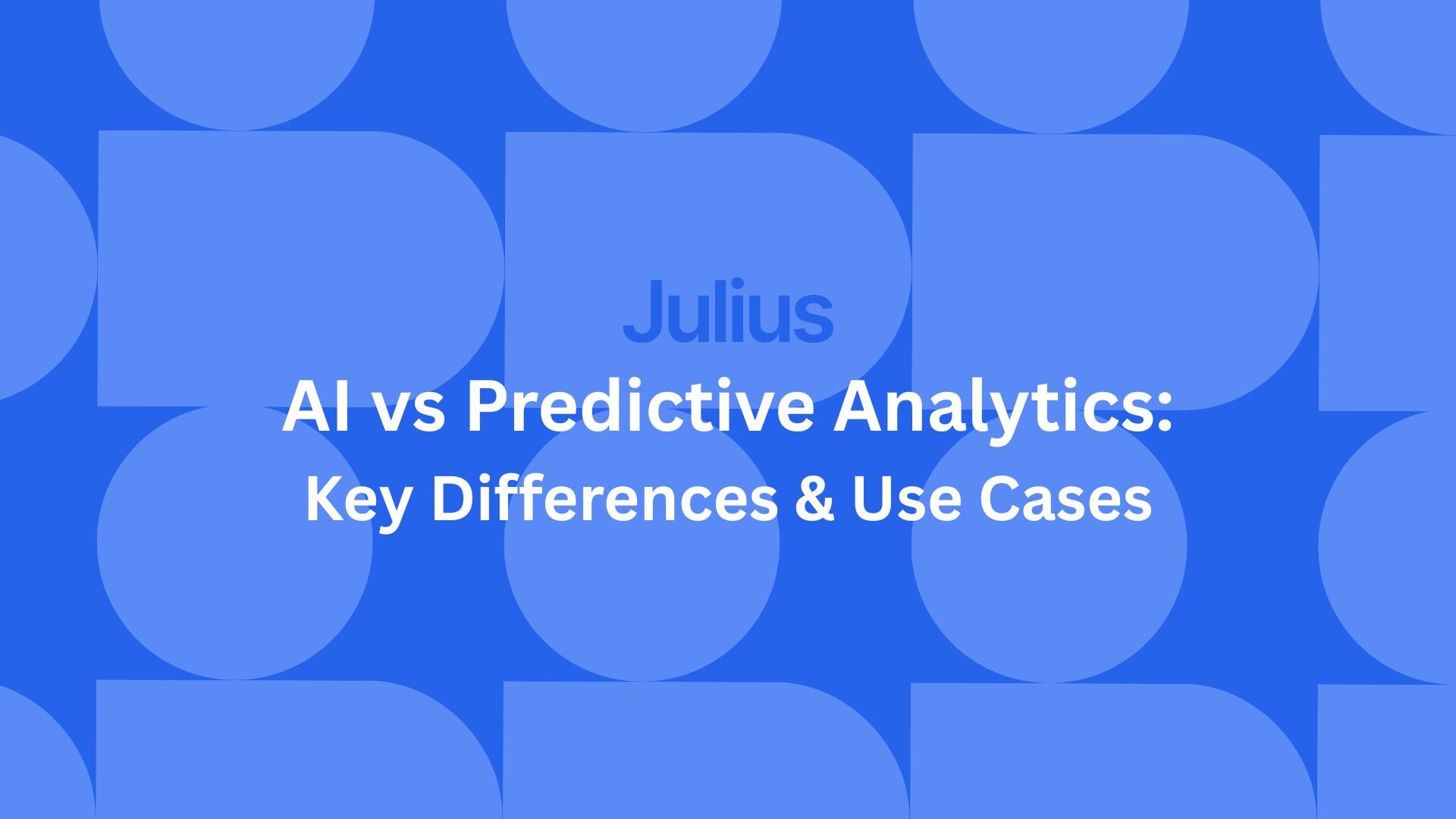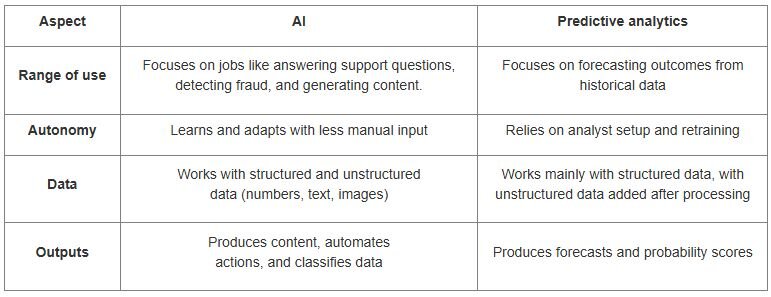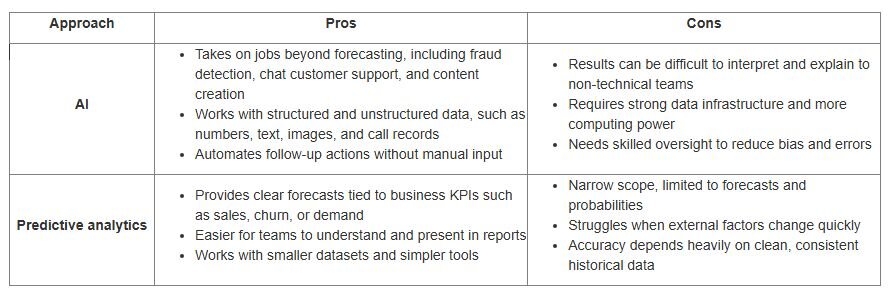September 16th, 2025
AI vs Predictive Analytics: Key Differences & Use Cases [2025]
By Tyler Shibata · 5 min read

The comparison between AI vs predictive analytics highlights the gap between a wide range of tools and a single forecasting approach. AI covers jobs like fraud detection or chatbots, while predictive analytics narrows in on forecasts such as sales or churn.
I’ve used both AI and predictive analytics in many projects. In this article, I’ll explain how they work, where they overlap, and practical business use cases in 2025.
AI vs predictive analytics: Key differences
When you compare AI and predictive analytics side by side, the contrasts become clear. I’ve seen the biggest differences show up in projects ranging from customer retention models to fraud checks, and they usually fall into a few core areas.
Here’s a side-by-side breakdown that shows how the two approaches differ in real business use:

Let’s take a look at some examples of both in practice in fields like:
Customer support: AI powers a chatbot to resolve tickets, while predictive analytics forecasts which customers are most likely to open a support case.
Fraud detection: AI detects unusual transactions in real time, while predictive analytics estimates the likelihood of fraud based on historical spending patterns.
Marketing: AI generates personalized ad copy, while predictive analytics predicts which audience segment is most likely to respond.
What is AI?
Artificial intelligence (AI) is technology that allows machines to perform jobs that usually need human intelligence, such as analyzing data, recognizing patterns, or making decisions. It works by using algorithms, often powered by machine learning, that process large amounts of information, identify patterns, and apply those patterns to new situations.
For businesses, this means AI can handle work at a speed and scale that people can’t match. Some common applications of AI include:
Finance: AI detects unusual transactions that point to fraud and flags them for review. Banks use these models to scan millions of transactions in real time, reducing the chance of fraud slipping through manual checks.
Customer service: AI powers chatbots that resolve questions around the clock without human intervention. These systems handle routine tickets quickly, which frees human agents to focus on more complex cases.
Marketing: AI generates tailored content or ad copy that speaks directly to customer interests. Marketers use it to draft product descriptions, adjust ad messaging for different audiences, and test variations faster than manual teams could manage.
I’ve used AI in campaign reporting where it flagged a sharp drop in mobile click-through rates in one region after a creative update. I hadn’t built a manual report for that segment, so the alert helped me catch the issue early and switch back to the older creative before losing more spend.
What is predictive analytics?
Predictive analytics is a data analysis method that uses historical data to forecast future outcomes, such as sales trends, customer churn, or loan defaults. It’s a subset of data analytics that sits alongside descriptive analytics, which looks at past results, and diagnostic analytics, which explains why they happened.
Where descriptive and diagnostic analytics stop at the past, predictive analytics estimates what’s likely to happen next. It relies on data analysis techniques like statistical models, supervised learning, and data mining to find patterns in past records and apply them to new situations.
Businesses use predictive analytics in areas such as:
Financial planning: Models predict late payment risks by analyzing client history and transaction records. These forecasts give teams a clearer view of expected cash flow and show which accounts to contact early before payment issues grow.
Marketing: Models estimate how likely different customer segments are to churn, which helps teams target retention campaigns more effectively.
Operations: Forecasts project product demand or resource needs so teams can adjust inventory and staffing in advance.
I’ve worked on a retail project where predictive analytics used two years of sales and seasonal data to forecast demand for specific product lines. The model showed a sharp rise in demand for winter gear starting three weeks earlier than the previous year. Based on that forecast, we increased inventory three weeks sooner and avoided stockouts during peak season.
Artificial intelligence vs predictive analytics: Similarities
Predictive analytics provides the framework for forecasting, while AI supplies advanced methods to improve accuracy or scale. I’ve seen this in churn projects where a basic regression model produced a risk score, and then machine learning boosted accuracy by factoring in more variables.
Another overlap shows up in data handling. While predictive analytics often starts with structured records like transactions or customer histories, AI makes it possible to bring in unstructured data such as emails or social posts once that information is processed into a usable format.
I worked on a project where customer emails were combined with purchase history. Predictive analytics built the forecast, and AI processed the text data to sharpen churn predictions.
The two approaches also connect in the same workflow. Predictive analytics generates a probability, like which accounts are most at risk, and AI extends that forecast by drafting outreach or automating the next step. Used together, they turn a risk score into immediate action, reducing the time between insight and response.
Pros and cons of both for businesses
AI and predictive analytics can both create value, but they also come with tradeoffs. Here are the pros and cons:

When to choose AI vs predictive analytics
• Intuitive and Conversational: Working with data with the aid of AI is a remarkably easy, intuitive process. You can just use simple language to ask the AI to do what you want, so you don’t need to dig too much into the nitty-gritty of complicated analytical terminology.
• Rapid Decision-Making: AI can provide insights far faster than even experienced data scientists, giving brands and individuals the information they need to make better decisions, without any delays.
• Democratization of Data and Insights: Vibe analytics, like vibe coding, makes processes that were once complex and locked off to large parts of the public more accessible to all. Almost anyone can upload data to a tool like Julius AI and start analyzing it with AI assistance.
• Enhanced Collaboration: Vibe analytics is also a great way to unite teams, including those that may lack the skills or experience necessary for more conventional analytical processes, so they can uncover insights together.
How to use AI and predictive analysis together in business
Businesses get the most value when AI and predictive analytics work together. Here’s how you can run that workflow using Julius:
Start with your business question: Ask Julius a question like, “Which customers are most likely to cancel next quarter?” or “How much revenue will we generate by region?” A clear question keeps the analysis focused.
Apply predictive analytics to get the forecast: Julius connects to your data sources and applies models to historical data, such as past subscription renewals or three years of regional sales. The output might be a probability (like a 70% chance of churn) or a numeric forecast (like $4.2M projected revenue).
Use AI to take action on the forecast: If predictive analytics flags high-risk accounts, AI can segment them and draft tailored retention offers. In Julius, those results can be exported for use in a CRM or marketing platform. If a revenue forecast points to a regional dip, AI can also recommend campaign changes or generate content ideas to test.
Integrate the workflow into your tools: Keep forecasts and actions where your team already works. With Julius, you can add churn scores to a dashboard, export data for your CRM, or schedule recurring reports to Slack and email. This makes the process easier to access and repeat.
Track outcomes with specific KPIs: Julius helps you compare predicted churn to actual churn, measure lift from campaigns, or see whether forecast accuracy improves over time. Those metrics guide adjustments and refine the process.
How Julius helps you apply AI and predictive analytics faster
AI and predictive analytics work best when the process is simple enough for everyday use. The challenge is finding an AI data analysis tool that brings those methods together without adding complexity.
Julius gives you one place to run forecasts, keep analyses organized, and share results without extra steps.
Here’s what you can do with Julius:
Ask questions in plain language: We designed Julius so you can just type a simple question and get a chart or forecast fast.
Keep analyses repeatable: Save a workflow, like a churn model or revenue forecast, and rerun it with updated data whenever you need.
Share insights automatically: Schedule recurring reports to send results straight to Slack or email so the team stays in the loop.
Track and compare over time: Store results from past runs to see how forecasts and outcomes change.
Hand off work easily: Share Notebooks so teammates can pick up where you left off without rebuilding the analysis.
Ready to see how you can ask, analyze, and share results faster with Julius? Try Julius for free today.
Frequently asked questions
Is predictive analytics AI?
No, predictive analytics is not the same as AI, but it can use AI methods. Predictive analytics focuses on forecasting outcomes from historical data, while AI covers a broader range of jobs like pattern recognition, automation, and content generation. You can use predictive analytics on its own, but many modern tools rely on AI algorithms to improve forecast accuracy.
Can predictive analytics work without AI?
Yes, predictive analytics can work without AI by using traditional statistical models like regression to forecast outcomes. You can still forecast sales, demand, or churn with these methods. AI becomes useful when you need to process larger datasets, include unstructured information, or improve accuracy with machine learning.
Is AI more accurate than predictive analytics?
No, AI is not always more accurate than predictive analytics. Accuracy depends on the quality of your data and the problem you’re solving. A simple predictive model can perform well for stable trends, while AI in data analysis is better suited for handling messy or unstructured inputs where patterns are harder to spot.
What are real-world business uses of predictive analytics?
Predictive analytics is used in business for forecasts and risk scoring. You can forecast revenue, identify customers at risk of leaving, predict late payments, or project product demand. These forecasts help you plan resources, target outreach, and improve financial planning.
Can AI and predictive analytics work together in one workflow?
Yes, AI and predictive analytics can work together in the same workflow. Predictive analytics produces the forecast, and AI can act on it by generating campaigns, automating responses, or analyzing additional unstructured data. You can use them together to move from insights to action faster.
What is the difference between machine learning and predictive analytics?
Machine learning is a branch of AI that builds algorithms to learn patterns and improve predictions, while predictive analytics is a business-focused approach that uses statistical methods, and sometimes machine learning, to forecast outcomes. Machine learning is the engine, and predictive analytics is the application in areas like sales, marketing, finance, or operations.
